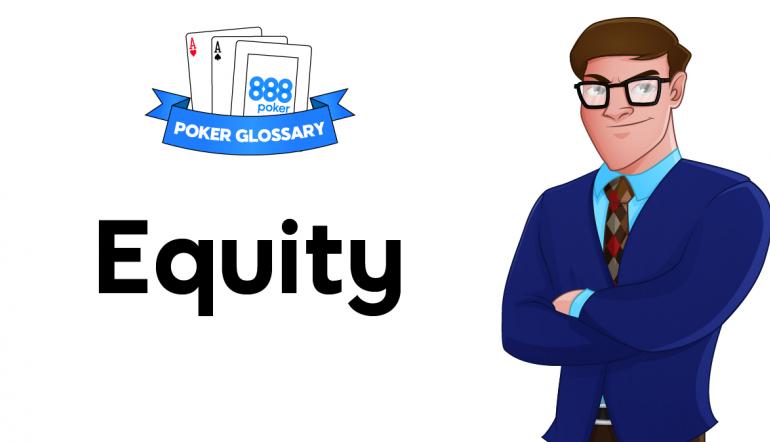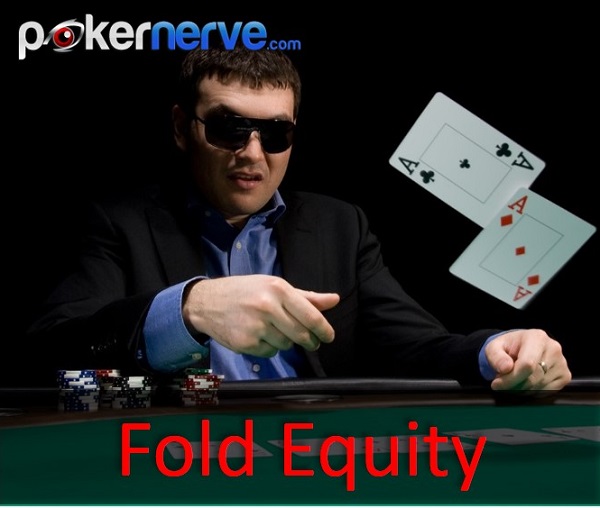Poker Term Fold Equity
Note (October 2014): This article needs to be re-written. Some of the stuff is okay, but the math needs to be fixed.
Until then, here's a 5 minute video on How To Use A Fold Equity Calculator.
— Greg
In this article I will cover the basics of fold equity and how it makes semi-bluffs profitable. It's a fairly simple concept though, so don't be too nervous about it.
If you don't know what equity is just yet, read up on the poker equity article before reading this one.

What is fold equity?
Fold equity is the additional equity you gain in the hand when you believe that there is a chance that your opponent will fold to your bet.
Every time you bet, there is the chance that your opponent will fold their hand. If our opponent folds, we win the entire pot regardless of how strong our hand is.
Essentially, fold equity is the extra amount of equity you gain when you factor in how likely your opponent is to fold. Working out the correct amount of fold equity relies heavily on your ability to read an opponent. In other words, you need to be fairly certain of your chances to get an opponent to fold. The formula to work it out is as follows. I use many tools when analyzing poker hands away from the tablebut one of my favorite tools is the fold equity calculator. This tool only requires a few simple inputs to give me information about how often my opponent needs to fold in order for me to run a bluff. Thinking in terms of fold equity allows a poker player to become creative with hands that would otherwise be folded if considered solely from the perspective of the hand’s chances of improving to the best hand on future betting rounds. That’s why you often see good poker players raise with otherwise suspect hands. Fold Equity Calculator: นำมาใช้งานยังไง หลังจากได้ใส่ตัวแปรและทำการคำนวณด้วย fold equity calculator กันแล้ว ตอนนี้เราจะมาดูเทคนิคการนำ “fold%” ตัวเลข.
Fold Equity The probability that one or all players will fold behind you.
This chance that our opponent will give up their hand to our bet will increase our overall equity in the hand because we are giving ourselves an additional opportunity to win the pot as opposed to just showing down the best hand.
So every time we bet when there is a chance that our opponent will fold we are adding that little extra equity to our hand. So when you bet, think of your overall equity like this:
Total Equity = fold equity + hand equity
If our opponent will always fold, we cannot lose and therefore have 100% equity. If we do get called, our hand has equity because it is going to win the pot a % of the time.

Therefore, our total equity is our fold equity + the equity our hand has when we get called.
On a basic level, fold equity can be summarized by the following simple statements:
- How much fold equity do we have?
- If we think it is likely that our opponent will fold to our bet, we have a lot of fold equity.
- If we think it is unlikely that our opponent will fold to our bet, we have little fold equity.
- If we do not think our opponent will fold to our bet, we have no fold equity.
Poker Term Fold Equity
How do you get fold equity?
To get fold equity you have to bet or raise. If you are not betting or raising then you are not giving your opponent the opportunity to fold, so you will have no fold equity.
But you're not trying to obtain fold equity. You either have it or you don't, and you make the best decision based on what you've got. Nonetheless:
- The looser our image, the less fold equity we're likely to have.
- The tighter our image, the more fold equity we're likely to have.
You'll have the most fold equity when you've played the hand in a way that makes it believable that you've got your opponent beat. It's all about your betting pattern and history.
I probably should have clarified this point at the start, but I'm sure the majority of you will have assumed that this was the case anyway.
Mathematics of fold equity.
When you make a bet, you are basically absorbing some of your opponent's equity in the hand if there is a chance that they will fold. Fold equity can be expressed by a straightforward equation:
Poker Term Fold Equity Calculator
Fold equity = (chance our opponent will fold) * (opponent's equity in the hand).
The % chance that your opponent will fold is based on your knowledge of your opponent. So for example, using your experience you could say that there is a good chance that your opponent will fold 75% of the time when making a bet in a certain situation.
Your opponent's equity in the hand is pretty self explanatory. It's just the % of the pot they expect to win on average by the river. More specifically, it's the % equity their range has, but don't worry about that for now.
Total equity in the hand.
Total equity = fold equity + hand equity
As you will remember, your total equity in the hand is your current equity plus your fold equity. Fold equity on it's own isn't all that useful, so we add it to our standard equity to give us our overall equity in the hand.
Fold equity example.
Let's say we are on the flop and we know that our opponent is holding K J on the following flop:
Flop: Q K 2
Our hand: 9 T - 42.4% equity.
Opponent's hand: K J - 57.6% equity.
I worked out the equity of each of these hands using PokerStove. Get it already.
Our opponent is first to act and bets in to us. However, we are a little short stacked and believe that if we push all-in there is a 50% chance that our opponent will fold. Without even having to work this out we can already guess that this is going to be a profitable play over the long run, but lets do the math anyway.
- Fold equity = (chance our opponent will fold) * (opponent's equity in the hand).
- Fold equity = (0.5) * (57.4).
- Fold equity = 28.8%.
Now let's find our total equity in the hand.
- Total equity = our current equity + fold equity.
- Total equity = 42.4% + 28.8%.
- Total equity = 71.2%.
So every time we shove all-in with our drawing hand we will have 71.2% equity in the hand on average. Therefore, whereas calling to complete our draw would be unprofitable with our 42.4% equity, the addition of fold equity in the hand makes our shove a profitable play over the long run.
The benefits of fold equity.
Fold equity is the reason why semi-bluffs can be profitable.
Fold equity is the driving force behind semi-bluffs. The vast majority of the time you will be using fold equity to your advantage when betting or raising with a flush or a straight draw.
Poker Term Fold Equity Definition
On their own, these draws will generally not have enough equity to make it worth calling bets and raises. However, if you are the one betting and raising, the addition of fold equity can turn the overall equity in your favour. So over the long run, well-played semi-bluffs with drawing hands will be profitable.
Read the article on playing drawing hands aggressively for further discussion on this topic.
Pure bluffs and fold equity.
Whether a pure bluff is profitable or not almost completely depends on fold equity. This is because if you have no equity in the hand based on the strength of your cards, you are relying on fold equity alone to make the bluff profitable. For example:
Board: Q K 2 8 2
Our hand: 9 T - 0% equity.
Opponent's hand: K J - 100% equity.
Unless you believe that your opponent is folding at least 50% of the time, your bluff is not going to be profitable. Your fold equity = total equity here (current equity = 0%), so if it's less than 50% you will be losing more money than you win over the long run.
Fold equity evaluation.
You're not expected to get out your calculator and work out your fold equity every time you run a bluff or a semi-bluff. However, you can gauge a fairly accurate idea of your fold equity and use it to influence your decision when contemplating a semi-bluff.
If you have little or no fold equity, strongly reconsider making that semi-bluff.
So don't worry about the numbers involved in fold equity during play, just familiarise yourself with it and go from there. Your semi-bluffing skills should improve nicely over time.
Related articles.
Go back to the awesome Texas Hold'em Strategy.
Comments